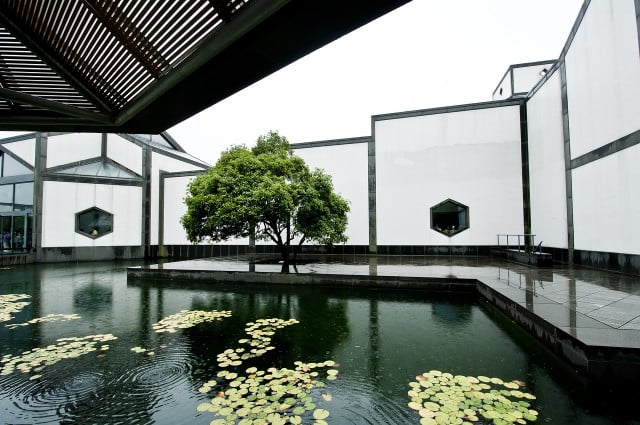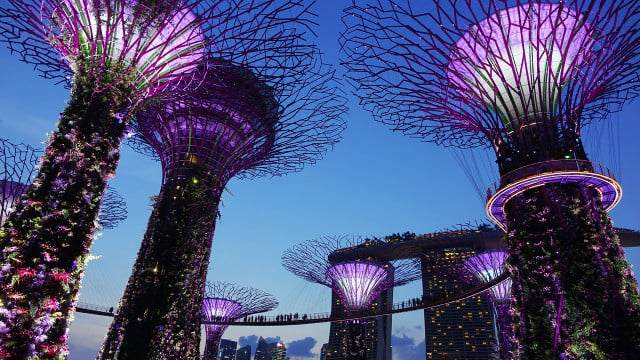Lunarpunk and solarpunk are subcultures that emerged from science fiction. We’ll explain these environment-focused aesthetics and why they work for a sustainable lifestyle.
With their roots in science fiction, solarpunk and lunarpunk started off as subcultures of this genre, shaping the aesthetic of stories about the future and how technology could improve our lives. Solarpunk has a strong environmental connection with images of green cities, sustainable tech, and linear, waste-free cycles. Lunarpunk goes a little deeper, as it’s built around a more personal connection with the environment, showcasing Wiccan aesthetics and elements like bioluminscence and fungi.
We’ll discuss how solarpunk and lunarpunk can be used to actively promote sustainable lifestyles and share some examples of the aesthetics involved in these movements.
What is Solarpunk?

The term solarpunk first came up in a 2008 blog post as an alternative to steampunk. Rather than existing as pure imagination and fantasy, like steampunk, it has an optimistic view of the future where innovative and sustainable technology solves environmental problems. Elements of the solarpunk aesthetic include floating villages, green cities, rainwater harvesting, vertical farming and one hundred percent clean energy. In a solarpunk world, humans live in harmony with nature in a sustainable circular system with no waste.
Decentralization is key to solarpunk, with a focus on communities that make decisions together, without hierarchy or dominance, thereby not accepting current capitalist systems. The “punk” part of the term refers to the refusal to follow the common negative narrative about the future, full of doom and gloom about climate change and biodiversity loss. Instead, it puts eco-anxiety to rest and instead takes a positive approach to activism, encouraging us to remain hopeful that technology will be able to provide solutions to environmental issues in the future.
The solarpunk vision looks at technology in a positive light. Instead of facilitating environmental exploitation, solarpunk technology assists in overcoming anthropogenic environmental issues such as pollution. Robots or machines are used to reduce reliance on exploitative human labor. A typical solarpunk aesthetic would show elements like solar panels, big windows, buildings designed for temperature regulation, and a plethora of greenery integrated into city structures.
What Is Lunarpunk?



The younger sibling of solarpunk, lunarpunk is an emerging sub-genre that is still being defined by the movement. However, compared to solarpunk, which embraces technology, lunarpunk focuses more on a spiritual connection with the environment and how activism in this can assist in its preservation. As a result, lunarpunk requires more reflection on an individual level, while considering your place within the natural environment and community.
Critics of solarpunk may claim that it relies too much on technology to “save” us, rather than reevaluating our relationship to things like food production. While solarpunk champions imagine a future in which technology and the environment coexist, lunarpunk followers see the natural world more at the forefront, suggesting that we should mold our behavior to the Earth’s natural rhythms.
The word “lunar” refers to the moon and in symbolism often represents emotions, the subconscious and change. As with solarpunk, the word “punk” is used to show rebellion against traditional systems and structures, while embracing decentralization, individual freedoms, and non-linear structures.
Environment-Focused Aesthetics



As we’ve discovered, the terms solarpunk and lunarpunk are both art movements inspired by science fiction. This means that artists have found many creative outlets using these themes, for example in storytelling, painting, and architecture. Some examples of creative work with environment-focused aesthetics that have elements of solarpunk in them are:
- Gardens By the Bay, Singapore — These towering vertical forests and cloud gardens have an art nouveau-style architecture.
- Marvel’s “Black Panther” movie — The mountainous surroundings of Wakanda shape the aesthetic of the city, where technology and architecture are fitted seamlessly into the landscape.
- Studio Ghibli animation — Some of the studio’s movies have elements of solarpunk ideas such as futuristic zero-waste buildings with inbuilt greenery.
- Singapore airport’s indoor waterfall — This architectural marvel recycles rainwater in a looped system and any excess water on rainy days is used for irrigation.
Lunarpunk aesthetics are a little different to solarpunk. The night and moon have a heavy influence on the artwork, as well as natural things like fungi, which grow at night and bioluminescence which can only be seen in the darkness. Colors focus on dark purples and blues, compared to the green, lighter colors of solarpunk.
Read more:
- Glow-in-the-Dark Trees — A Realistic Solution for Streetlights?
- Fridays For Future USA: What You Should Know About the Movement
- Why Climate Change Will Make Coffee Rare
Do you like this post?






